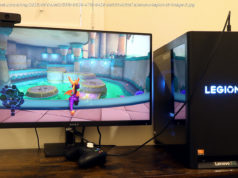Meet the most powerful Galaxy S8 on the market
Not a lot of phone makers out there can consider themselves direct rivals to Apple and the increased level of innovation that Samsung has reached lately bumped it even further, with many considering the S8 lineup real iPhone killers.
And without a doubt, there’s definitely some truth behind these words: the Galaxy S series has evolved so much in the last few years that many hardcore Apple customers decided to jump ship, just because Android devices manufactured by the South Korean firm come with so many features that iPhone users can only dream about.
The same thing for the Galaxy S8. When Samsung launched it earlier this year, it was pretty clear from the very beginning that this is another super-powerful rival to Apple’s iPhone and at closer inspection, it comes with features that iFans are still drooling after. A bezel-less display, a facial recognition system, truly exquisite design, all make the Galaxy S8 the second-best Android smartphone so far.
Why second? Because you can actually get something that’s better than that. It’s a more powerful Galaxy S8+ that you can only purchase in Korea and China and which comes with 6GB RAM (as compared to 4GB on the international model) and 128GB storage (up from 64GB worldwide) .
Basically, you get a bump in specs right where it’s the most important, so the phone should be faster, especially when writing and reading data, and offer more storage to make microSD cards unnecessary.
But is there such a big difference between the Korean and the international versions? Is it worth paying more on the S8+ just because of these hardware upgrade? Let’s find out together in the review.
The design of the phone is just as exquisite as you know it, as there are no visual differences between the Korean Galaxy S8+ and the international version. You get the same stunning Infinity Display, the signature “edge” curved screen, Gorilla Glass 5, and pretty much every single feature that you’ re spoiled with if you purchase the phone from Europe or the United States.
The Galaxy S8+ remains one of the most beautiful smartphones on the market, and by removing the physical home button, Samsung has achieved what only a few phone makers managed to do to until now: a screen to body ratio of no less than 84 percent, which is substantially better than the 67.7 percent on the iPhone 7 Plus.
As compared to Apple’s phone, which comes with huge bezels that make it look old and outdated, the Galaxy S8+ feels nice in hand, and the glass body offers a premium feeling no matter the angle.
“ Stunning design. ”
The hardware upgrades bring no increase in terms of dimensions and weight, so the phone still measures 159.5 x 73.4 x 8.1 mm (6.28 x 2.89 x 0.32 in) and tips the scales at 173 g (6.10 oz) . Again, this is a major improvement over the iPhone 7 Plus, which measures 158.2 x 77.9 x 7.3 mm (6.23 x 3.07 x 0.29 in) and has a weight of 188 g (6.63 oz) .
This means that the two phones have nearly the same dimensions but with the Galaxy S8+ offering substantially more screen space thanks to the 6.2-inch display and the super-narrow bezels.
The S8+ is beautifully crafted front and back, and while the front is dominated by the display with 18.5: 9 aspect ratio, the back is clean and puts the focus on the camera.
But there’s that little thing that everyone seems to be complaining about on the S8+: the fingerprint sensor is placed on the back in a pretty unusual position, and given how tall the device actually is, having your fingerprint scanned is quite a challenge. On the good side, Samsung is offering a facial recognition system using camera embedded in the top bezel on the front, so if you don’ t like the position of the fingerprint sensor, there’s always an alternative.
Unfortunately, we’ ve found the facial recognition rather unreliable at this point, so in the end, you must live with the oddly placed fingerprint sensor. It’s a small compromise for an otherwise stunning device.
The hardware section is the one that’s making the difference between the Korean and the international versions of the Galaxy S8+, though the first comes with only a bunch of upgrades that you’ re unlikely to notice when it comes to real-time performance.
#Display
The display, for instance, brings nothing special, though there’s no doubt it’s already special on the standard version of the Galaxy S8+. Samsung equipped its flagship device with a 6.2-inch screen with 1440×2960 pixels and 529 ppi pixel density, and this is a substantial upgrade over the iPhone 7 Plus whose 5.5-inch screen has a resolution of 1080×1920 px and 401 ppi.
Samsung’s OLED display is covered in Gorilla Glass 5, which is the toughest protection at this point, and contributes to the 84 percent screen to body ratio, up from 67.7 percent on the iPhone, all thanks to the narrow bezels that Samsung calls Infinity Display.
The default full HD+ resolution can be changed to Quad HD+ in settings, and the color modes can be further tweaked to make your photos look more natural.
With a display ratio of 18.5: 9, videos need special adjustments to fit the screen, and Samsung has provided several modes in this regard, although zooming in the image leads to some top and bottom parts being left out. This is particularly annoying when watching a football game, for instance, when the score is shown right in the top left corner and there’s a good chance it doesn’ t make it to the zoomed in display mode entirely.
Other than that, colors are amazing, and the advantages of OLED displays are more than obvious, with black being really black and the contrast featuring just the right level. Furthermore, there are the Samsung extras, like the Always On Display, which shows the time and the missed notifications on screen similarly to Microsoft’s old Nokia Lumia models.
Despite being so tall, the screen is clearly what makes the S8+ special, especially thanks to the combination of the curved edges and the narrow bezels. And between the Korean version and the international S8+, there’s no difference, so you won’ t have to pay the extra money just because of the screen.
#CPU, GPU, RAM, storage
Depending on the version you choose, the Samsung Galaxy S8+ is available with a choice of two processors, namely the Exynos 8895 in international markets and the Qualcomm MSM8998 Snapdragon 835 in the United States and China.
The Korean version that we’ re testing uses the Exynos octa-core chip in the following configuration: 4 x Samsung Exynos M1 @ 2.31 GHz and 4 x ARM Cortex A53 @ 1.69 GHz. The chip is paired with 6GB of RAM, and this is one of the big differences versus the international and the US versions of the device.
While the other S8+ versions come with 4GB RAM, Samsung is offering 6GB on this one, which most of the time is an upgrade that the majority of people don’ t need. What we’ ve noticed, however, is that this Korean version of the S8+ benefits from faster read and write speeds, with files also being indexed a bit faster when working with microSD cards for instance.
“ 6GB RAM and 128GB storage. ”
The US version comes with the Adreno 540 GPU, while the international S8+ can be purchased with the Mali G71 GPU renderer that is also available on our review unit.
As far as storage is concerned, Samsung typically offers the S8+ with 64GB, but if you go for this very special configuration, you get 128GB built-in storage. Again, this is a substantial upgrade that you’ ll benefit from especially if you record mostly videos, though microSD card support is available on every other version and you can boost storage by up to 256GB. The SIM2 slot can also be used for an additional microSD card, which means that overall, you can expand storage by a maximum of 512GB.
All in all, the differences between this more expensive model and the international S8+ are more notable in terms of storage, but as far as the RAM is concerned, there’s a good chance you’ re not going to feel anything different too often.
#Camera
Let’s put it this way from the very beginning: even though the Samsung Galaxy S8+ does not come with a dual-camera configuration like the iPhone 7 Plus, there’s pretty much nothing to lose, except the 2x optical zoom which is pretty much useless 90 percent of the time anyway.
The S8 uses a 12-megapixel Dual Pixel sensor with f1.7 and 1.4um pixel size. Before you get excited about that Dual Pixel thing, you must know this is a technology that Samsung introduced with the S7 edge and which helps increase the pixel size, which in turn allows more light to reach the sensor. This leads to brighter photos in low light conditions.
“ Nearly perfect ”
The camera comes with 4K support and it’s certainly ready for action at any moment. The focus is lightning fast, though we’d say it’s faster on the HTC U11 and on the Google Pixel XL, and for the majority of users, everything should be just perfect.
Photos obviously look stunning in most of the cases, and colors are vivid with well-balanced contrast and fine details.






